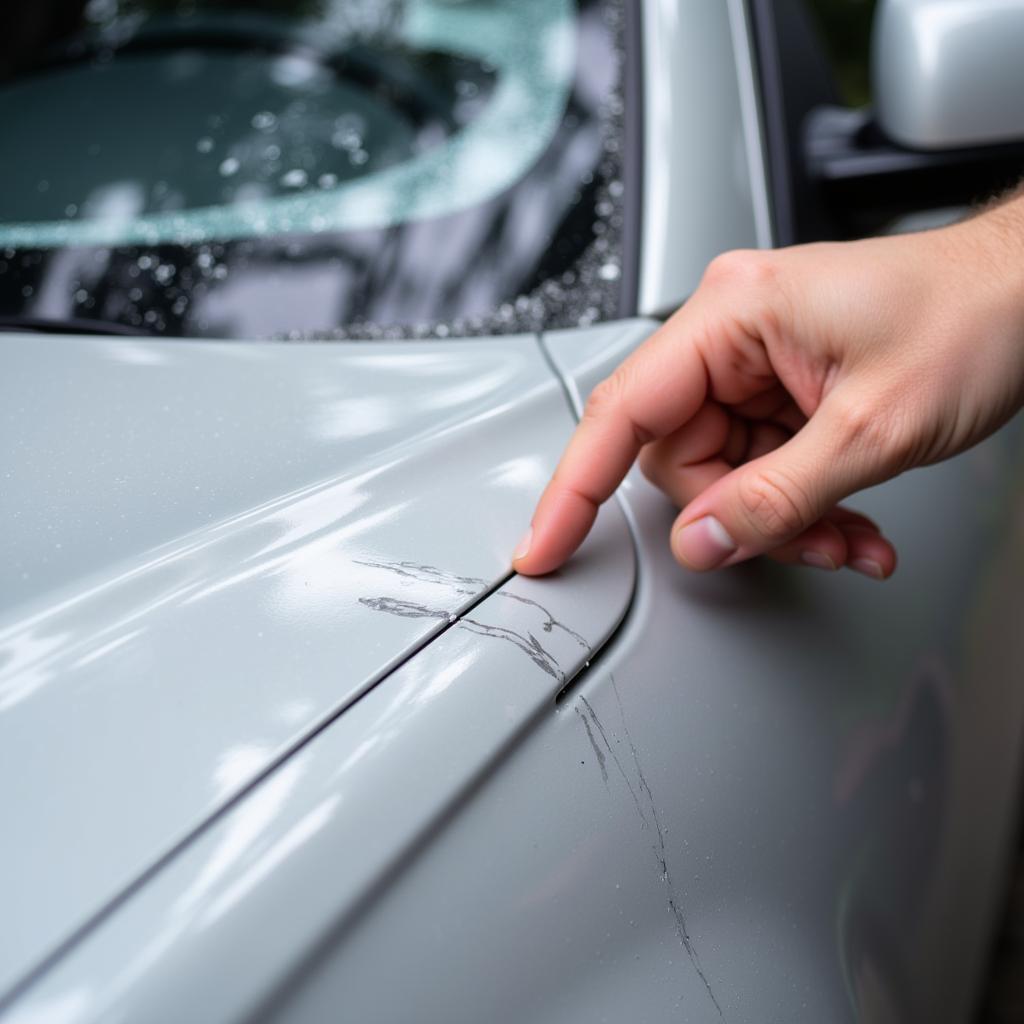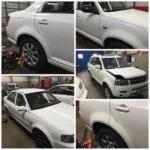At home car paint repair can be a cost-effective solution for minor scratches and chips. This guide will walk you through the process, offering expert tips and techniques for achieving professional-looking results without breaking the bank. We’ll cover everything from assessing the damage to selecting the right tools and materials, ensuring you’re well-equipped to tackle those pesky paint imperfections.
Assessing Your Car’s Paint Damage
Before diving into at home car paint repair, it’s crucial to assess the extent of the damage. Is it a light scratch, a deep gouge, or a chipped paint area? The severity of the damage will dictate the appropriate repair method. For light scratches, a simple polishing compound might suffice. Deeper scratches may require touch-up paint and clear coat, while significant damage might necessitate professional intervention. Properly identifying the damage type will ensure you choose the correct repair approach.
After washing and drying the affected area, examine it closely in good lighting. Run your fingernail gently across the scratch. If your nail catches, it indicates a deeper scratch requiring more than just polishing. Determining the depth of the damage is the first step towards a successful at home car paint repair.
Gathering Your Car Paint Repair Supplies
Once you’ve assessed the damage, gather your at home car paint repair supplies. For minor scratches, you’ll need a polishing compound, applicator pads, and microfiber cloths. Deeper scratches require touch-up paint, primer (if the scratch reaches the metal), clear coat, sandpaper (various grits), masking tape, and a rubbing compound. Car paint repair at home can be made easier with the right tools and materials. Investing in quality products will yield better results.
Remember, preparation is key for home car paint repair. Having all the necessary supplies at hand will make the process smoother and more efficient.
Step-by-Step Guide to At-Home Car Paint Repair
Here’s a detailed guide on how to repair car paint damage at home:
- Clean the Area: Thoroughly wash and dry the damaged area to remove any dirt or debris.
- Sanding (if necessary): For deeper scratches, start with a coarser grit sandpaper (e.g., 1500 grit) and gradually move to a finer grit (e.g., 2000 grit) to smooth the surface. How to repair car paint damage at home often involves sanding for deeper scratches.
- Apply Primer (if necessary): If the scratch has reached the metal, apply a thin coat of primer to prevent rust.
- Apply Touch-Up Paint: Carefully apply the touch-up paint to the damaged area, ensuring a thin and even coat. Multiple thin coats are better than one thick coat.
- Apply Clear Coat (if necessary): Once the touch-up paint dries, apply a thin layer of clear coat to protect the repair and blend it with the surrounding paint.
- Sand and Polish: After the clear coat dries, wet sand with fine-grit sandpaper (e.g., 2500 grit) and then polish the area with a rubbing compound to achieve a smooth and glossy finish.
Tips for a Professional Finish
- Work in a well-ventilated area: Paint fumes can be harmful.
- Use thin coats of paint and clear coat: This prevents runs and drips.
- Be patient: Allow each coat to dry completely before applying the next.
- Practice on a less visible area first: This will help you get a feel for the process.
“A successful at home car paint repair relies heavily on the preparation work. Take your time and be meticulous in each step, from cleaning to polishing,” advises John Smith, Senior Automotive Technician at Smith Auto Repair.
Conclusion
At home car paint repair can save you money and time, especially for minor damage. By following these steps and tips, you can achieve professional-looking results and restore your car’s appearance. Mountain home car paint repair offers a convenient solution for those looking to maintain their vehicle’s aesthetics. Remember, patience and attention to detail are key to a successful DIY car paint repair.
FAQs
-
Can I repair deep scratches at home? Yes, but deep scratches requiring primer application may be more challenging and might benefit from professional repair.
-
What type of touch-up paint should I use? Use touch-up paint specifically designed for your car’s make, model, and year to ensure a perfect color match.
-
How long does it take for touch-up paint to dry? Drying times vary depending on the type of paint and environmental conditions, typically between 30 minutes to a few hours.
-
Do I need to apply clear coat? Clear coat is recommended for protecting the repair and blending it with the surrounding paint, especially for deeper scratches.
-
Can I use household cleaning products to clean the area before repair? No, use automotive-specific cleaning products to avoid damaging the paint.
-
What if the repair doesn’t look perfect? Minor imperfections are often unavoidable with DIY repairs. If you’re not satisfied with the results, consider seeking professional help.
-
Where can I find car paint repair supplies? Auto parts stores, online retailers, and some hardware stores carry car paint repair supplies.
“For more complex repairs or if you’re unsure about any step, consulting a professional is always a good idea,” recommends Jane Doe, Lead Auto Detailer at Doe’s Detailing.
For other related articles, check out car paint repair at your home.
Need help? Contact us via WhatsApp: +1(641)206-8880 or Email: [email protected]. Our customer service team is available 24/7.


